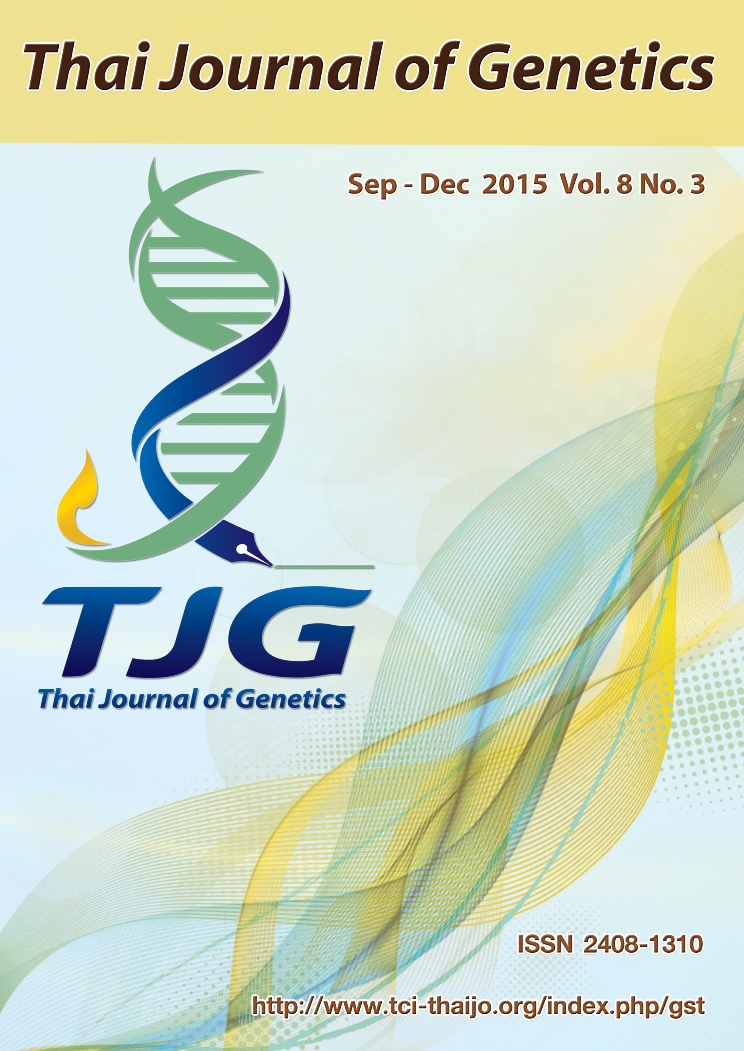Detection of microdeletion syndromes using Fluorescence in situ hybridization in Thais
Keywords:
Fluorescence in situ Hybridization (FISH), microdeletion, DiGeorge/velocardiofacial syndrome, Williams syndrome, Prader Willi/Angelman syndromeAbstract
Microdeletion syndromes are a collection of genetic disorders that are associated with very small deletions on certain chromosomes, which may not be detected by conventional karyotyping. However, these microdeletions can be detected by the Fluorescence in situ hybridization (FISH). Total of 427 cases with suspected microdeletion syndromes (DiGeorge/Velocardiofacial syndrome, Williams syndrome and PraderWilli/Angelman syndrome were 306, 67 and 54 cases, respectively) in Ramathibodi Hospital during 2010-2014 were detected by FISH using the specific probes. Out of 427 samples, we found that 84 (19.7%) were positive for microdeletion syndromes. Among of these, 41 (48.8%) were DiGeorge/velocardiofacial syndrome, 30 (35.7%) were Williams syndrome and 13 (15.5%) were PraderWilli/Angelman syndrome. These results indicated that any of 3 microdeletion syndromes can be diagnosed by FISH technology which provides prognostic information for patients and their parents, as the genes responsible for the phenotypic aspects of various microdeletion syndromes are identified.
References
Battaglia A (2008) The inv dup (15) or idic (25) syndrome (Tetrasomy 15q). Orphanet Journal of Rare Diseases. http://www.ojrd.com/content/3/1/30 (November 2013)
Belloso JM, Caballin MR, Gabau E, Baena N, Vidal R, Villatoro S, Guitart M (2005) Characterization of six marker chromosomes by comparative genomic hybridization. Am J Med Genet 136A: 169–174.
Cassidy SB, Schwartz S, Miller JL, Driscoll DJ (2012) Prader-Willi syndrome. Genet Med 14: 10–26.
Dale RC, Grattan-Smith P, Nicholson M, Peters GB (2012) Microdeletions detected using chromosome microarray in children with suspected genetic movement disorders: a single-centre study. Dev Med Child Neurol 54: 618–623.
Delach JA, Rosengren SS, Kaplan L, Greenstein RM, Cassidy SB, Benn PA (1994) Comparison of high resolution chromosome banding and fluorescence in situ hybridization (FISH) for the laboratory evaluation of Prader-Willi syndrome and Angelman syndrome. Am J Med Genet 52: 85–91.
Dissaneevate S, Jaruratanasirikul S, Chanvithan P, Janjindamai W (2003) Congenital malformations of newborns at Songklanagarind Hospital. Songkla Med J 21: 267-276.
Ensenauer RE, Adeyinka A, Flynn HC, Michels VV, Lindor NM, Dawson DB, Thorland EC, Lorentz CP, Goldstein JL, McDonald MT, et al. (2003) Microduplication 22q11.2, an emerging syndrome: clinical, cytogenetic, and molecular analysis of thirteen patients. Am J Hum Genet 73: 1027–1040.
García-Herrero S, Campos-Galindo I, Martínez-Conejero JA, Serra V, Olmo I, Lara C, Simón C, Rubio C (2014) BACs-on-Beads technology: A reliable test for rapid detection of aneuploidies and microdeletions in prenatal diagnosis. BioMed Research International 2014: 1–7.
Jalali GR, Vorstman JAS, Errami A, Vijzelaar, Biegel J, Shaikh T, Emanuel BS (2008) Detailed analysis of 22q11.2 with a high density MLPA probe set. Hum Mutat 29: 433–440.
Madon PF, Athalye AS, Sanghavi K, Parikh FR (2010) Microdeletion syndromes detected by FISH – 73 positive from 374 cases. Int J Hum Genet 10: 15–20.
Moorhead PS, Nowell PC, Mellman WJ, Battips DM, Hungerford DA (1960) Chromosome preparations of leukocytes cultured from human peripheral blood. Exp Cell Res 20: 613–616.
Shaffer LG, Ledbetter DH, Lupski JR (2001) Molecular cytogenetics of contiguous gene syndromes: mechanisms and consequences of gene dosage imbalance. In: Scriver CR, Beaudet AL, Sly WS, Valle D, Vogelstein B, et al., The online metabolic and molecular bases of inherited diseases. 8th ed. McGraw-Hill. New York, pp 1291–1324.
Sinclair A (2002) Genetics 101: cytogenetics and FISH. CMAJ 167: 373–374.
Sukarova-Angelovska E, Piperkova K, Sredovska A, Ilieva G, Kocova M (2007) Implementation of fluorescent in situ hybridization (FISH) as a method for detecting microdeletion syndromes - our first experiences. Prilozi 28: 87–97.
Tongsong T (2010) Cystic Hygroma. Obstetrics and Gynecology CMU. http://www.med.cmu.ac.th/dept/ obgyn/2011/index.php?option=com_content&view=article&id=63:cystic-hygroma&catid=43&Itemid=401 (November 2010)
Vanneste E, Melotte C, Debrock S, D'Hooghe T, Brems H, Fryns JP, Legius E, Vermeesch JR (2009) Preimplantation genetic diagnosis using fluorescent in situ hybridization for cancer predisposition syndromes caused by microdeletion. Hum Reprod 24: 1522–1528
Vissers LE, Stankiewicz P (2012) Microdeletion and microduplication syndromes. Methods Mol Biol 838: 29–75.
Vogels A, Fryns JP (2015) Microdeletions and Molecular Genetics. Atlas of Genetics and Cytogenetics in Oncology and Haematology, http://atlasgeneticsoncology.org/Educ/MicrodeletionID30059ES.html (February 2015)
Weksberg R, Hughes S, Moldovan L, Bassett AS, Chow EW, Squire JA (2005) A method for accurate detection of genomic microdeletions using real-time quantitative PCR. BMC Genomics 6: 180–190.
Weise A, Mrasek K, Klein E, Mulatinho M, Llerena JC Jr, Hardekopf D, Pekova S, Bhatt S, Kosyakova N, Liehr T (2012) Microdeletion and microduplication syndromes. J Histochem Cytochem 60: 346–358.
Xu J, Chen Z (2003) Advances in molecular cytogenetics for the evaluation of mental retardation. Am J Med Genet C Semin Med Genet 117C: 15–24.



